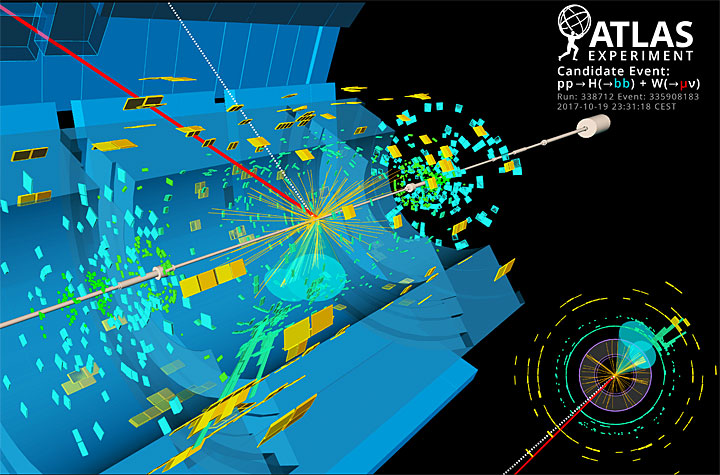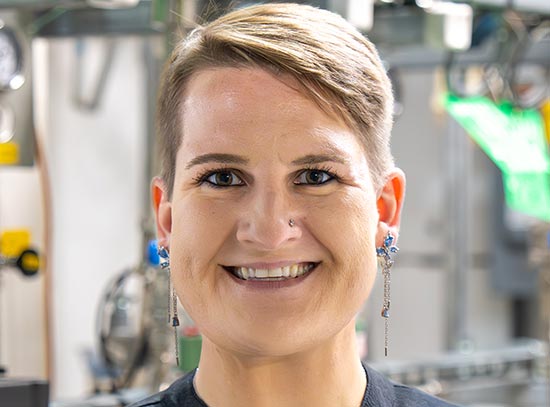LHC Scientists Detect Most Favored Higgs Decay
Scientists now know the fate of the vast majority of all Higgs bosons produced in the LHC
August 28, 2018
 enlarge
enlarge
Event display for candidate Higgs boson decay into a pair of bottom quarks recorded by the ATLAS experiment. (Image courtesy of ATLAS experiment @ CERN)
The following news release about new research results from the Large Hadron Collider (LHC) is being issued by the U.S. Department of Energy's Brookhaven National Laboratory on behalf of the U.S. LHC organization: http://uslhc.web.cern.ch/. In addition to serving as the U.S. host laboratory for the ATLAS experiment at the LHC, Brookhaven National Laboratory plays multiple roles in this international collaboration, from construction and project management to data storage, distribution, and analysis. For more information about Brookhaven's role in research at ATLAS, see: http://www.bnl.gov/atlas/. To interview a Brookhaven Lab scientist about these new results, contact Peter Genzer, 631-344-3174, genzer@bnl.gov.
Today at CERN, the Large Hadron Collider collaborations ATLAS and CMS jointly announced the discovery of the Higgs boson transforming into bottom quarks as it decays. This is predicted to be the most common way for Higgs bosons to decay, yet was a difficult signal to isolate because background processes closely mimic the subtle signal. This new discovery is a big step forward in the quest to understand how the Higgs enables fundamental particles to acquire mass.
After several years of refining their techniques and gradually incorporating more data, both experiments finally saw evidence of the Higgs decaying to bottom quarks that exceeds the 5-sigma threshold of statistical significance typically required to claim a discovery. Both teams found their results were consistent with predictions based on the Standard Model.
“The Higgs boson is an integral component of our universe and theorized to give all fundamental particles their mass,” said Patty McBride, distinguished scientist at the U.S. Department of Energy’s Fermi National Accelerator Laboratory and recently elected as one of the deputy spokespeople of the CMS experiment. “But we haven’t yet confirmed exactly how this field interacts—or even if it interacts—with all the particles we know about, or if it interacts with dark matter particles, which remain to be detected.”
Higgs bosons are only produced in roughly one out of a billion LHC collisions and live only a tiny fraction of a second before their energy is converted into a cascade of other particles. Because it’s impossible to see Higgs bosons directly, scientists use these secondary particle decay products to study the Higgs’ properties. Since its discovery in 2012, scientists have been able to identify only about thirty percent of all the predicted Higgs boson decays. According to Viviana Cavaliere, a physicist at DOE’s Brookhaven National Laboratory who works on the ATLAS experiment, finding the Higgs boson decaying into bottom quarks has been priority number one for the last several years because of its large decay rate.
“Theory predicts that sixty percent of Higgs bosons decay into bottom quarks,” said Cavaliere, who is also using this process to search for new physics. “Finding and understanding this channel is critical because it opens up the possibility for us to examine the behavior of the Higgs, such as whether it could interact with new, undiscovered particles.”
The Higgs field is theorized to interact with all massive particles in the Standard Model, the best theory scientists have to explain the behavior of subatomic particles. But many scientists suspect that the Higgs could also interact with massive particles outside the Standard Model, such as dark matter. By finding and mapping the Higgs bosons’ interactions with known particles, scientists can simultaneously probe for new phenomena.
“A fraction of Higgs bosons could be producing dark matter particles as part of their decay,” said Giacinto Piacquadio, a physicist at Stony Brook University who co-led the Higgs-to-bottom-quarks analysis group. “Because the decay of the Higgs boson to bottom quarks is so common, we can use it to put constraints on potentially invisible decays as well as use it to probe for new physics directly.”
Even though this decay is the most popular path, spotting it in the experimental data was no walk in the park. Every proton-proton collision at the LHC produces a splattering of subatomic byproducts, one of the most common being bottom quarks. These bottom quarks then quickly decay into other kinds of particles, leaving behind vast showers of particles in the detectors. Tracing these particle showers back to two bottom quarks (and then figuring out which ones came from a Higgs boson) is extremely delicate and labyrinthine work.
“Being able to identify and isolate bottom quarks in the experimental data is a huge challenge and required precise detector calibration and sophisticated b-quark tagging,” said Piacquadio. “We were only able to do these analyses thanks to years of work that came before.”
To spot this process, the ATLAS and CMS collaborations each combined data from the first and second runs of the LHC and then applied complex analysis methods to the data.
“Finding just one event that looks like two bottom quarks originating from a Higgs boson is not enough,” says Chris Palmer, a scientist at Princeton University who worked on the CMS analysis. “We needed to analyze hundreds of thousands of events before we could illuminate this process, which is happening on top of a mountain of similar-looking background events.”
According to Palmer, these deceptive background events made the analyses almost impossible to perform based on isolated bottom quarks alone.
“Luckily, there are a few Higgs production mechanisms that produce identifiable particles as byproducts,” said Palmer. “We used these particles to tag potential Higgs events and separate them out from everything else. So we really got a two-for-one deal with this analysis because not only did we find the Higgs decaying to bottom quarks, but we also learned a lot about its production mechanisms.”
The next step is to increase the precision of these measurements so that scientists can study this decay mode with a much greater resolution and explore what secrets the Higgs boson might be hiding.
More than 1,700 scientists, engineers and graduate students from the United States collaborate on the experiments at the LHC, most of them on the CMS and ATLAS experiments, through funding by the Department of Energy Office of Science and the National Science Foundation. Brookhaven National Laboratory serves as the lead national laboratory for participation in the ATLAS experiment, and Fermi National Accelerator Laboratory serves as the lead national laboratory for participation in the CMS experiment.
CERN, the European Organization for Nuclear Research, is the world’s leading laboratory for particle physics. It has its headquarters in Geneva. At present, its member states are Austria, Belgium, Bulgaria, the Czech Republic, Denmark, Finland, France, Germany, Greece, Hungary, Israel, Italy, the Netherlands, Norway, Poland, Portugal, Romania, Slovakia, Spain, Sweden, Switzerland and the United Kingdom. Cyprus, Slovenia and Serbia are associate members in the pre-stage to membership. India, Lithuania, Ukraine, Turkey and Pakistan are associate members. Japan, the Russian Federation, the United States of America, the European Union, JINR and UNESCO have observer status.
The National Science Foundation (NSF) is an independent federal agency that supports fundamental research and education across all fields of science and engineering. In fiscal year (FY) 2018, its budget is $7.8 billion. NSF funds reach all 50 states through grants to nearly 2,000 colleges, universities and other institutions. Each year, NSF receives more than 50,000 competitive proposals for funding and makes about 12,000 new funding awards.
Brookhaven National Laboratory is supported by the Office of Science of the U.S. Department of Energy. The Office of Science is the single largest supporter of basic research in the physical sciences in the United States, and is working to address some of the most pressing challenges of our time. For more information, please visit science.energy.gov.
Follow @BrookhavenLab on Twitter or find us on Facebook.
Media contacts:
- Sarah Charley, USLHC communicator, sarah.charley@cern.ch
- Andre Salles, Fermilab Office of Communication, media@fnal.gov, 630-840-3351
- Peter Genzer, Brookhaven Lab Media & Communications Office, genzer@bnl.gov, 631-344-3174
2018-13081 | INT/EXT | Newsroom









